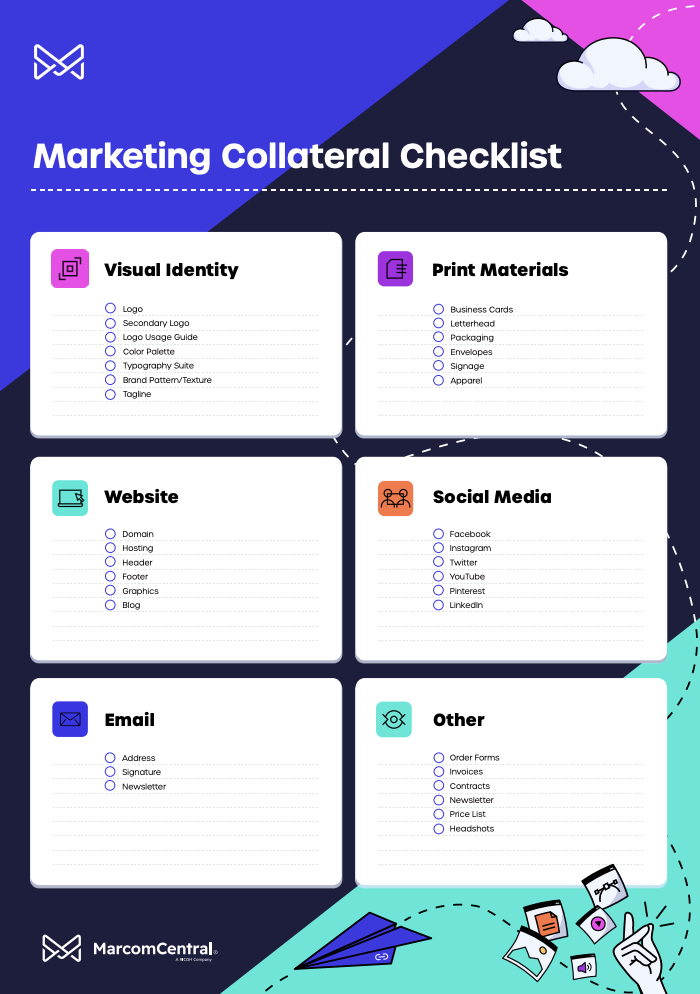- Tip 1: Set up asset categories based on marketing and sales needs
- Tip 2: Organize marketing assets for buyer personas
- Tip 3: Group collateral by buyer’s journey or sales funnel stage
- Tip 4: Update, update, update!
- Tip 5: Centralize and standardize locations and formatting
Get news, updates, and insights delivered straight to your inbox.
5 Tips to Organize Marketing Collateral

First off, what is marketing collateral exactly?
Marketing collateral is marketing material used in email marketing, advertising, and digital marketing such as social media posts, blog posts, and live event collateral material. Marketing collateral includes any piece of content that the marketing team uses to help with the sales process. Keeping all of these pieces on brand is one of the biggest challenges many marketing managers face.
We previously discussed how marketers’ laptops often resemble a messy storage closet, holding a plethora of brand assets and marketing materials with little organization. This can happen when organizations use shared drives to house their marketing assets and neglect the upkeep of these drives. As a result, finding branded templates or other pieces of sales collateral can be a huge headache.
What exactly are the consequences of disorganized marketing content in today’s competitive marketplace? Consumers are used to getting what they want, when they want it. If sales and marketing teams are unable to deliver promotional materials that incentivize an engagement of some sort (i.e. newsletter sign-up, a purchase, etc.) in an acceptable amount of time, customers will jump ship to the next competing brand that gives them what they want and need. This is why brand managers are expected to move quickly, fleshing out a high volume of content to get in front of both potential and current customers as soon as possible. An easy strategy to facilitate getting your content to market faster? Organization.
While keeping your marketing assets organized seems easier said than done, there are several steps you can take to ensure that your collateral can be found quickly and easily. Follow these five tips to stay ahead of the curve and eliminate the scourge of cluttered marketing collateral.
Tip 1: Set up asset categories based on marketing and sales needs
Marketing collateral organization doesn’t begin at campaign launch – it starts with asset design. For example, a Twitter sharecard goes through multiple rounds of ideation and revision before a brand tweets it out, starting with a design brief describing the purpose of the asset. Before you begin to group your assets, consider what collateral your business produces. The design process should be what drives the categorization of these marketing assets. For instance, does your organization prioritize digital marketing with heavy production of social media graphics, email newsletters, blog posts, or infographics? Taking a detailed inventory of your digital marketing collateral and design assets allows you to know exactly what you’re working with. Knowing what categories of collateral you’re producing to help support your marketing team and sales efforts will ultimately help you formulate the best way to create space in your brand portal.

FREE MARKETING COLLATERAL CHECKLIST
Download our visual checklist to ensure your marketing assets are on-brand and ready to go.
Download the Free Checklist
Tip 2: Organize marketing assets for buyer personas
If your brand is looking to target a new audience or focus on new prospective customers, consider organizing your marketing assets by buyer personas. Actionable buyer personas reveal insights about your buyer’s decisions – insights that can (and should) help you organize your marketing assets. By organizing your content library into specific buyer persona categories, sales reps will be able to locate resources used to target specific customers. For an effective marketing collateral strategy, consider also grouping your assets by attributes like income, demographics, and goals. By clearly defining target customers, your sales team will be set up for success in their next marketing campaign endeavor.
Tip 3: Group collateral by buyer’s journey or sales funnel stage
If your brand is launching a full funnel marketing campaign, consider organizing collateral with the buyer’s journey in mind. Understand that your brand has unique prospective clients at various stages of the sales funnel, and not all of these potential customers should be marketed to in the same way. For example, an all-natural skincare brand wouldn’t want to target someone who’s already in the decision stage with a blog on the negative effects of sulfates in cleansers, as the consumer has already been made aware of this. As part of your content marketing strategy, think about developing a variety of assets for customers and then organizing this collateral based on where they fall in the sales funnel: awareness, consideration, or decision stage. Better known as sales enablement, this strategy can greatly improve productivity by empowering sales teams with on-demand access to content across all stages of the sales funnel.
Include problem-based content like ebooks, blog posts, and videos in the awareness stage folder. Group solution-based content like webinars and whitepapers together for consumers in the consideration stage. Finally, have resources like case studies, product comparison charts, and product literature like brochures available for potential customers in the decision stage. By organizing collateral based on stages in the buyer’s journey, you can help ensure that the right assets are being put in front of the right clients, making sure that marketing efforts aren’t going to waste.
Tip 4: Update, update, update!
While centralizing your assets is a crucial step in your marketing collateral strategy, keeping these assets up-to-date is even more imperative. Old or duplicate versions of content can lead to confusion and inconsistency with regard to which brand materials are being used, which can ultimately deteriorate brand equity. By eliminating old or duplicate content, you significantly lower your risk of incorrectly branded materials being used for marketing campaigns while protecting brand consistency. Aside from this, your sales team can feel confident that they are adhering to brand guidelines, knowing that your organization’s centralized marketing assets are updated regularly.
Tip 5: Centralize and standardize locations and formatting
Many organizations use shared drives to house their collateral. However, storing marketing assets in multiple drives can make finding a specific piece of marketing collateral a real burden, especially when a marketer is trying to act quickly. If your organization has collateral in various drives, centralize all of your content into a single brand portal. Unlike a shared drive, a brand portal does more than just house assets – it helps users leverage assets while upholding the standards of your brand guidelines. The brand portal will act as a one-stop-shop for branded collateral materials, saving salespeople and marketing teams time and effort when looking for specific templates, as well as increasing accessibility. Additionally, make sure that the file naming structure within your brand portal remains consistent. This will help eliminate confusion around where specific files are located and empower teams to learn where to find updated assets themselves.
Companies devote a lot of time and money to creating branded content, but this marketing collateral is of little use if team members are unable to find and use it to support sales and marketing efforts. A brand portal housing all of your assets is a great start but for the most effective approach to marketing asset organization, consider utilizing a marketing asset management (MAM) solution. Marketing asset management ensures that all content is centralized within a designated brand portal so that marketers don’t have to waste time searching for specific assets in various drives. A marketing asset management solution also helps to enforce brand guidelines through automatic updates so you don’t have to deal with outdated images, trademarks, and logos. This provides marketers with a single source of truth and allows them to confidently launch marketing campaigns without fear of jeopardizing brand identity or consistency. With marketing asset management incorporated into your brand’s marketing collateral strategy, sales and marketing teams can efficiently locate various assets and get content in front of your audience in a timely manner. That alone could make all the difference in closing a sales deal!
For more information on how marketing asset management solutions can help simplify marketing collateral organization, be sure to check out our marketing asset management solutions.


